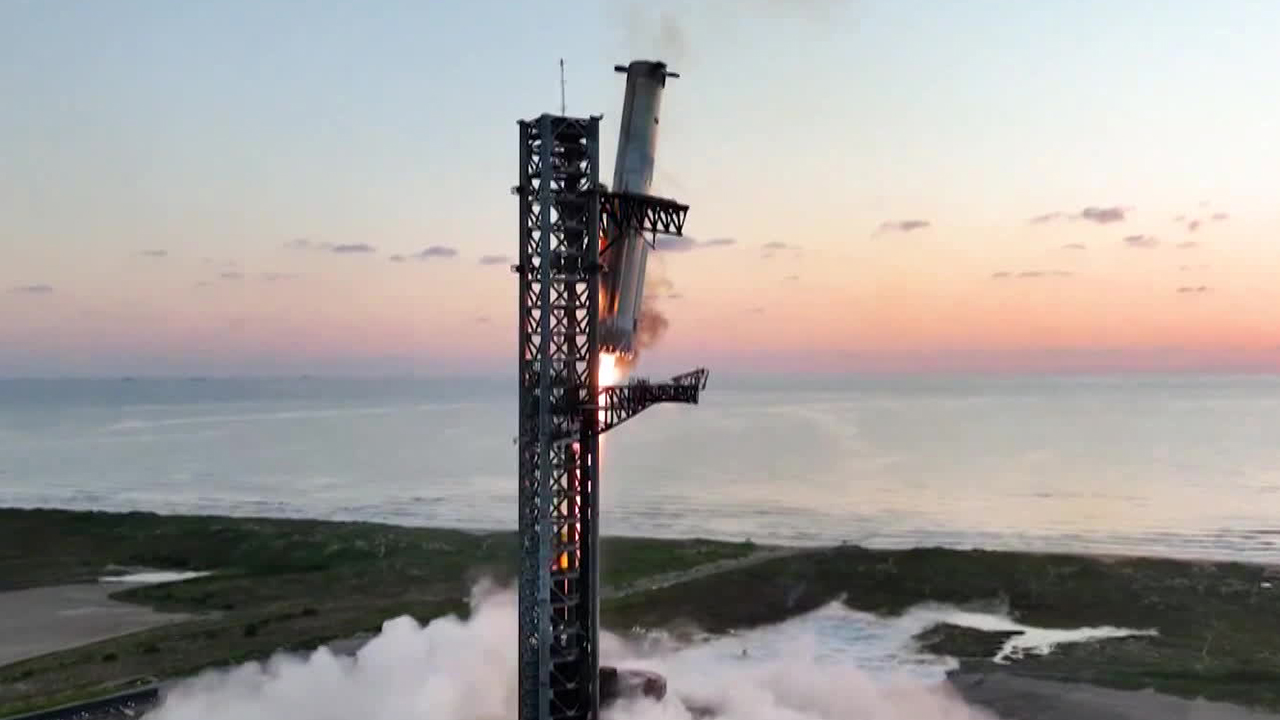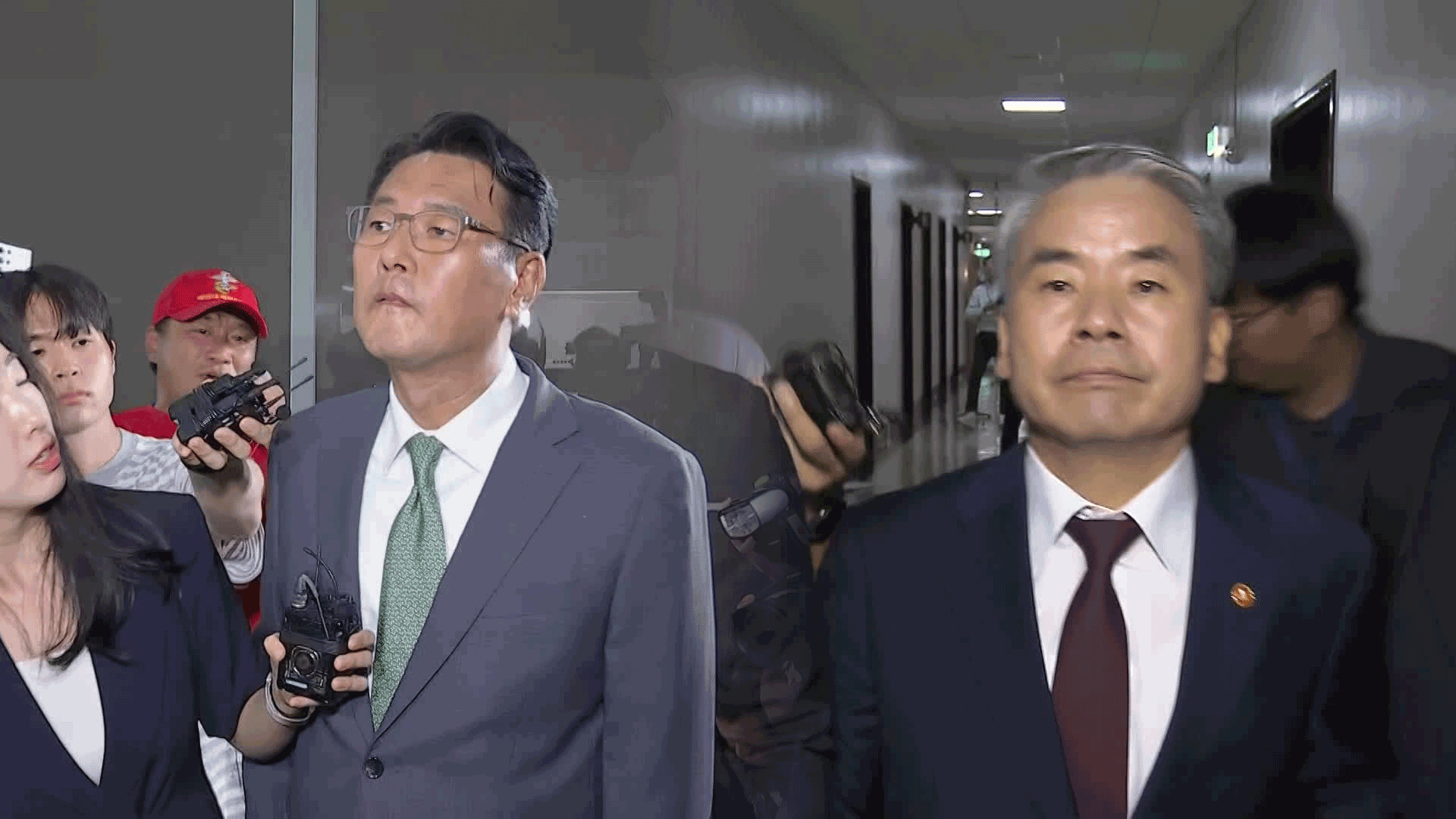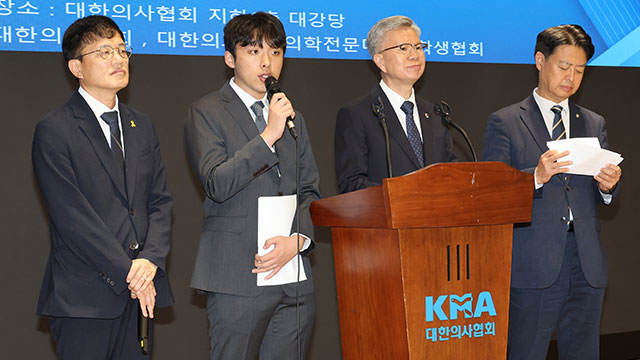‘Reverse thrust’ for rocket reuse: What about us?
입력 2024.10.16 (23:50)
읽어주기 기능은 크롬기반의
브라우저에서만 사용하실 수 있습니다.
[Anchor]
We have reported that the American space company SpaceX has successfully returned a massive rocket, the height of a 23-story apartment building, to its launch site.
The key to this groundbreaking success in reducing space development costs was the retropropulsion technology. Our reporter Shin Ji-soo has investigated how far our companies have come in this technology.
[Report]
The 'Super Heavy' rocket was launched into the sky.
It returns in just 7 minutes and fits perfectly into the robotic arm of the launch pad.
This is the first successful method of rocket recovery achieved by SpaceX.
It is being evaluated as a new history of rocket reuse, as it can significantly reduce costs compared to landing on land or at sea.
[Kate Tice/SpaceX Engineer: "This is absolutely insane. On the first ever attempt we have successfully caught the super heavy booster back at the launch tower."]
The core technology is 'retropropulsion', which controls the falling speed.
By precisely controlling the power of the 33 engines at the bottom, it reduces speed and adjusts direction as if pressing the brakes.
For the rocket to maintain balance and land accurately at the target point, this technology must be perfectly implemented.
[Kim Seung-jo/Honorary Professor, Department of Aerospace Engineering, Seoul National University: "Initially, 13 engines reduced speed when entering the atmosphere, and then just before landing, 3 engines reduced speed."]
Domestic companies are also diving into the development of technology for rocket reuse.
At the end of last year, they successfully conducted a vertical takeoff and landing test up to 100 meters using retropropulsion technology.
[Lee Eun-gwang/Vice President, Perigee Aerospace: "We have secured the pearls. However, to make the necklace, we ultimately need to create this (integrated control) system, so more investment and financial resources are needed for the system."]
The Korea Aerospace Administration also plans to secure rocket reuse technology, including retropropulsion, by 2030.
This is KBS News, Shin Ji-soo.
We have reported that the American space company SpaceX has successfully returned a massive rocket, the height of a 23-story apartment building, to its launch site.
The key to this groundbreaking success in reducing space development costs was the retropropulsion technology. Our reporter Shin Ji-soo has investigated how far our companies have come in this technology.
[Report]
The 'Super Heavy' rocket was launched into the sky.
It returns in just 7 minutes and fits perfectly into the robotic arm of the launch pad.
This is the first successful method of rocket recovery achieved by SpaceX.
It is being evaluated as a new history of rocket reuse, as it can significantly reduce costs compared to landing on land or at sea.
[Kate Tice/SpaceX Engineer: "This is absolutely insane. On the first ever attempt we have successfully caught the super heavy booster back at the launch tower."]
The core technology is 'retropropulsion', which controls the falling speed.
By precisely controlling the power of the 33 engines at the bottom, it reduces speed and adjusts direction as if pressing the brakes.
For the rocket to maintain balance and land accurately at the target point, this technology must be perfectly implemented.
[Kim Seung-jo/Honorary Professor, Department of Aerospace Engineering, Seoul National University: "Initially, 13 engines reduced speed when entering the atmosphere, and then just before landing, 3 engines reduced speed."]
Domestic companies are also diving into the development of technology for rocket reuse.
At the end of last year, they successfully conducted a vertical takeoff and landing test up to 100 meters using retropropulsion technology.
[Lee Eun-gwang/Vice President, Perigee Aerospace: "We have secured the pearls. However, to make the necklace, we ultimately need to create this (integrated control) system, so more investment and financial resources are needed for the system."]
The Korea Aerospace Administration also plans to secure rocket reuse technology, including retropropulsion, by 2030.
This is KBS News, Shin Ji-soo.
■ 제보하기
▷ 카카오톡 : 'KBS제보' 검색, 채널 추가
▷ 전화 : 02-781-1234, 4444
▷ 이메일 : kbs1234@kbs.co.kr
▷ 유튜브, 네이버, 카카오에서도 KBS뉴스를 구독해주세요!
- ‘Reverse thrust’ for rocket reuse: What about us?
-
- 입력 2024-10-16 23:50:01

[Anchor]
We have reported that the American space company SpaceX has successfully returned a massive rocket, the height of a 23-story apartment building, to its launch site.
The key to this groundbreaking success in reducing space development costs was the retropropulsion technology. Our reporter Shin Ji-soo has investigated how far our companies have come in this technology.
[Report]
The 'Super Heavy' rocket was launched into the sky.
It returns in just 7 minutes and fits perfectly into the robotic arm of the launch pad.
This is the first successful method of rocket recovery achieved by SpaceX.
It is being evaluated as a new history of rocket reuse, as it can significantly reduce costs compared to landing on land or at sea.
[Kate Tice/SpaceX Engineer: "This is absolutely insane. On the first ever attempt we have successfully caught the super heavy booster back at the launch tower."]
The core technology is 'retropropulsion', which controls the falling speed.
By precisely controlling the power of the 33 engines at the bottom, it reduces speed and adjusts direction as if pressing the brakes.
For the rocket to maintain balance and land accurately at the target point, this technology must be perfectly implemented.
[Kim Seung-jo/Honorary Professor, Department of Aerospace Engineering, Seoul National University: "Initially, 13 engines reduced speed when entering the atmosphere, and then just before landing, 3 engines reduced speed."]
Domestic companies are also diving into the development of technology for rocket reuse.
At the end of last year, they successfully conducted a vertical takeoff and landing test up to 100 meters using retropropulsion technology.
[Lee Eun-gwang/Vice President, Perigee Aerospace: "We have secured the pearls. However, to make the necklace, we ultimately need to create this (integrated control) system, so more investment and financial resources are needed for the system."]
The Korea Aerospace Administration also plans to secure rocket reuse technology, including retropropulsion, by 2030.
This is KBS News, Shin Ji-soo.
We have reported that the American space company SpaceX has successfully returned a massive rocket, the height of a 23-story apartment building, to its launch site.
The key to this groundbreaking success in reducing space development costs was the retropropulsion technology. Our reporter Shin Ji-soo has investigated how far our companies have come in this technology.
[Report]
The 'Super Heavy' rocket was launched into the sky.
It returns in just 7 minutes and fits perfectly into the robotic arm of the launch pad.
This is the first successful method of rocket recovery achieved by SpaceX.
It is being evaluated as a new history of rocket reuse, as it can significantly reduce costs compared to landing on land or at sea.
[Kate Tice/SpaceX Engineer: "This is absolutely insane. On the first ever attempt we have successfully caught the super heavy booster back at the launch tower."]
The core technology is 'retropropulsion', which controls the falling speed.
By precisely controlling the power of the 33 engines at the bottom, it reduces speed and adjusts direction as if pressing the brakes.
For the rocket to maintain balance and land accurately at the target point, this technology must be perfectly implemented.
[Kim Seung-jo/Honorary Professor, Department of Aerospace Engineering, Seoul National University: "Initially, 13 engines reduced speed when entering the atmosphere, and then just before landing, 3 engines reduced speed."]
Domestic companies are also diving into the development of technology for rocket reuse.
At the end of last year, they successfully conducted a vertical takeoff and landing test up to 100 meters using retropropulsion technology.
[Lee Eun-gwang/Vice President, Perigee Aerospace: "We have secured the pearls. However, to make the necklace, we ultimately need to create this (integrated control) system, so more investment and financial resources are needed for the system."]
The Korea Aerospace Administration also plans to secure rocket reuse technology, including retropropulsion, by 2030.
This is KBS News, Shin Ji-soo.
-
-

신지수 기자 js@kbs.co.kr
신지수 기자의 기사 모음
-
이 기사가 좋으셨다면
-
좋아요
0
-
응원해요
0
-
후속 원해요
0















이 기사에 대한 의견을 남겨주세요.